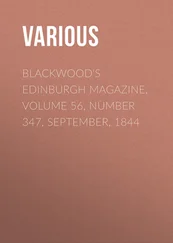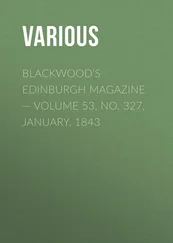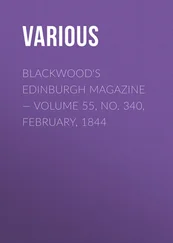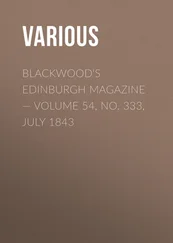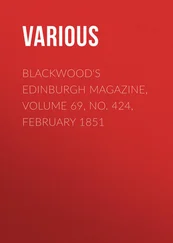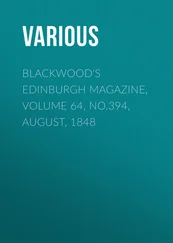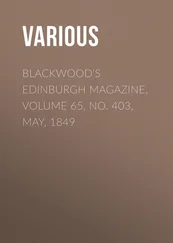Various - Blackwood's Edinburgh Magazine, Volume 58, No. 359, September 1845
Здесь есть возможность читать онлайн «Various - Blackwood's Edinburgh Magazine, Volume 58, No. 359, September 1845» — ознакомительный отрывок электронной книги совершенно бесплатно, а после прочтения отрывка купить полную версию. В некоторых случаях можно слушать аудио, скачать через торрент в формате fb2 и присутствует краткое содержание. Издательство: Иностранный паблик, Жанр: periodic, foreign_edu, Путешествия и география, на английском языке. Описание произведения, (предисловие) а так же отзывы посетителей доступны на портале библиотеки ЛибКат.
- Название:Blackwood's Edinburgh Magazine, Volume 58, No. 359, September 1845
- Автор:
- Издательство:Иностранный паблик
- Жанр:
- Год:неизвестен
- ISBN:нет данных
- Рейтинг книги:4 / 5. Голосов: 1
-
Избранное:Добавить в избранное
- Отзывы:
-
Ваша оценка:
- 80
- 1
- 2
- 3
- 4
- 5
Blackwood's Edinburgh Magazine, Volume 58, No. 359, September 1845: краткое содержание, описание и аннотация
Предлагаем к чтению аннотацию, описание, краткое содержание или предисловие (зависит от того, что написал сам автор книги «Blackwood's Edinburgh Magazine, Volume 58, No. 359, September 1845»). Если вы не нашли необходимую информацию о книге — напишите в комментариях, мы постараемся отыскать её.
Blackwood's Edinburgh Magazine, Volume 58, No. 359, September 1845 — читать онлайн ознакомительный отрывок
Ниже представлен текст книги, разбитый по страницам. Система сохранения места последней прочитанной страницы, позволяет с удобством читать онлайн бесплатно книгу «Blackwood's Edinburgh Magazine, Volume 58, No. 359, September 1845», без необходимости каждый раз заново искать на чём Вы остановились. Поставьте закладку, и сможете в любой момент перейти на страницу, на которой закончили чтение.
Интервал:
Закладка:
Mr Leslie has remarked this peculiarity in several of Constable's pictures. Speaking of Constable's Boat-building , he observes – "In the midst of a meadow at Flatford, a barge is seen on the stocks, while, just beyond it, the river Stour glitters in the still sunshine of a hot summer's day. This picture is a proof, that in landscape, what painters call warm colours are not necessary to produce a warm effect. It has, indeed, no positive colour, and there is much of gray and green in it; but such is its atmospheric truth, that the tremulous vibration of the heated air near the ground seems visible." Again, with regard to a small view from Hampstead heath. "The sky is of the blue of an English summer day, with large but not threatening clouds of a silvery whiteness. The distance is of a deep blue, and the near trees and grass of the freshest green; for Constable could never consent to patch up the verdure of nature to obtain warmth. These tints are balanced by a very little warm colour on a road and gravel-pit in the foreground, a single house in the middle distance, and the scarlet jacket of a labourer. Yet I know no picture in which the mid-day heat of summer is so admirably expressed; and were not the eye refreshed by the shade thrown over a great part of the foreground by some young trees that border the road, and the cool blue of water near it, one would wish in looking at it for a parasol, as Fuseli wished for an umbrella when standing before one of Constable's showers."
It was probably the manner of Constable's execution, as much as any thing else, which for a time interposed a serious obstacle to his success; particularly with artists or persons accustomed to attend to the executive detail of painting. "My pictures will never be popular," he said, "for they have no handling; but I do not see handling in nature." His aim, in fact, though we must admit it was not always successful, was to exhibit art, but not artifice – to efface all traces of the mere mode of execution – to conceal the handwriting of the painter, and to imitate those mysterious processes by which nature produces her effects, where all is shadowy, glimmering, indefinable, yet pregnant with suggestion. In Turner more than any other modern artist – for in this respect we think he far excelled Constable – is this alchymy of art carried to perfection. Look closely at his pictures, and a few patches, dashes, and streaks only are visible, which seem a mere chaos of colour; but retire to the proper distance, what magnificent visions grow into shape; how the long avenue lengthens out for miles; how the sun-clad city brightens on the mountain – the stream descends from the eye – the distance spreads out into infinity! – all these apparently unmeaning spots or accidents of colour, in which it is difficult to detect the work of the hand or pencil at all, being, in fact, mysterious but speaking hieroglyphics, based on profound combinations of colour and light and shadow, and full of the finest harmonies to all who can look at nature with the eye of imagination.
Constable, a we have said, was not always successful in this, the most hazardous of all attempts in painting. If the touches of pure white, which he seemed to scatter on his trees as if from a half-dry brush, sometimes assisted the dewy effect which he loved to produce, they very often, from the absence of that power of just calculation which Turner seems so unerringly to possess, produced a spotty effect, as if the trees had been here and there powdered with snow. Very frequently he exchanged the pencil for the palette knife, in the use of which he was very dexterous, but which, Mr Leslie admits, he occasionally carried to a blamable excess, loading his pictures with a relievo of colour, and provoking the remark, that if he had not attained breadth, he had at least secured thickness.
On the whole, Constable, though now and then missing his object – sometimes, it would seem, as in his skies, from overlabouring his effect, and trying too studiously to arrest and embody fleeting effects – was eminently successful in the result at which he aimed – that of conveying vividly, and almost irresistibly, the sentiment and delineative character of the scene. We have already quoted Fuseli's well-known remark, when standing before one of his showery pictures. "I feel the wind blowing on my face," was honest Jack Banister's remark, (no bad judge by the by,) while contemplating another of his breezy scenes, with the rolling clouds broken up by means of sunshine, and the bending trees turning out their lighter lining to the gale. "Come here," was the remark of a French painter, in the exhibition of the Louvre in 1824; "look at this picture by an Englishman — it is steeped in dew ." "We never ask," said Mr Purton, "whether his figures be well or ill placed; there they are, and unless they choose to move on, there they must remain ." This truth and artlessness, and natural action or repose of his figures, only equalled in the English landscape by those of Gainsborough and Collins, he probably owed, in some measure, to an observation of an early acquaintance – Antiquity Smith, as he was nicknamed by his brother artists, who, at the commencement of his studies, had given him this judicious advice: – "Do not set about inventing figures for a landscape taken from nature; for you cannot remain an hour on any spot, however solitary, without the appearance of some living thing, that will, in all probability, accord better with the scene and time of day than will any invention of your own."
With Constable's strong natural tastes, and his long-considered views of landscape – at least that landscape for which he felt a vocation – it may be doubted whether he would have gained any thing by an acquaintance with continental scenery, leading, as it generally does, to the adoption of a certain fixed mode of treatment, or even by a more familiar intercourse with the grander features of our own country. He seems to have felt that his originality was, in some degree, connected with the intimacy of his acquaintance with that domestic nature, the study of which he chiefly cultivated, and which was matured by constant repetition and comparison of impressions. A circuit of a few miles, in fact, bounds his bosky bourne from side to side; a circuit of a few hundred yards embraces the subject of nearly half his favourite studies. "The Dutch," he says in one of his journals, "were stay-at-home people; hence the source of their originality."
"In the education of an artist," says Mr Leslie with great good sense, "it is scarcely possible to foresee what circumstances will prove advantageous or the reverse; it is on looking back only that we can judge of these things. Travelling is now the order of the day – and it may sometimes prove beneficial; but to Constable's art, there can be little doubt that the confinement of his studies with the narrowest bounds in which, perhaps, the studies of an artist ever were confined, was in the highest degree favourable; for a knowledge of atmospheric effects will be best attained by a constant study of the same objects, under every change of seasons and of the times of day. His ambition, it will be borne in mind, was not to paint many things imperfectly, but to paint a few well."
A motto, in truth, worthy of any of the seven sages – applicable to many things besides painting – and which can scarcely be applied in vain to any. Not many things imperfectly, but a few well!
With these imperfect remarks on the general character of Constable's pictures, we pass at once to a few extracts from the correspondence, which, as we have already said, makes up the substance of the present volume. Among the letters, by much the most striking and amusing are those of Constable's early and steady friend, Archdeacon Fisher – an admirable judge of art, and himself a very respectable artist. His excellent sense – his kindness – his generosity – which laboured to make its object forget the boon, or at least the benefactor; his strong attachment to his order, yet with a clear perception of the drawbacks inherent in the English hierarchical system; the caustic and somewhat cynical turn of his remarks on contemporary art – communicate great spirit, liveliness, and interest to his letters. In many things he resembles Paley, of whom he seems to have been a warm admirer. He had a thorough appreciation of the excellences of Constable, both moral and professional; but he had a keen eye also to the occasional weaknesses, want of method, and inattention to trifles, which now and then disfigured them. "Pray," he enquires on one occasion, "how many dinners a-week does your wife get you to eat at a regular hour and like a Christian?" "Where real business is to be done," said he, speaking of and to Constable, on another occasion, "you are the most energetic and punctual of men. In smaller matters – such as putting on your breeches – you are apt to lose time in deciding which leg shall go in first."
Читать дальшеИнтервал:
Закладка:
Похожие книги на «Blackwood's Edinburgh Magazine, Volume 58, No. 359, September 1845»
Представляем Вашему вниманию похожие книги на «Blackwood's Edinburgh Magazine, Volume 58, No. 359, September 1845» списком для выбора. Мы отобрали схожую по названию и смыслу литературу в надежде предоставить читателям больше вариантов отыскать новые, интересные, ещё непрочитанные произведения.
Обсуждение, отзывы о книге «Blackwood's Edinburgh Magazine, Volume 58, No. 359, September 1845» и просто собственные мнения читателей. Оставьте ваши комментарии, напишите, что Вы думаете о произведении, его смысле или главных героях. Укажите что конкретно понравилось, а что нет, и почему Вы так считаете.

